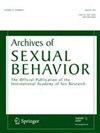Help-Seeking for Sexual Difficulties Among Australian Men: Analysis of the Ten to Men Longitudinal Study.
IF 2.9
2区 社会学
Q1 PSYCHOLOGY, CLINICAL
引用次数: 0
Abstract
Sexual difficulties are common among Australian men, affecting over half the population regardless of age or sexual identity. It can have significant impacts on physical health, mental well-being, and quality of life if left untreated. The present study aimed to examine sexual difficulty trends, sources of seeking help, and factors associated with sexual help-seeking behavior among a cohort of Australian men. Four waves of data from the Australian Longitudinal Study on Male Health (Ten to Men) were used in the analysis. We included men aged 18 years and above who had engaged in vaginal, oral, or anal sex, leading to a total sample size of 12,737 (wave 1), 8,933 (wave 2), 6,991 (wave 3), and 5,804 (wave 4) men. Logistic regression was undertaken to identify factors associated with sexual help-seeking behavior. Across the four waves, there was a significant rise in the prevalence of men experiencing at least one form of sexual difficulty, increasing from 54.1% (95% CI 52.7, 62.5) in 2013/14 to 64.7% (95% CI 62.8, 66.7) in 2022. The increase in prevalence of sexual difficulties was more pronounced among men from culturally and linguistically diverse backgrounds which increased from 42.8% (95% CI 38.1, 47.5) in 2013/14 to 61.5% (95% CI 55.6, 67.1) in 2022. Around 17.6% of men sought assistance for their sexual health concerns in 2022, with no significant change over the study period. Number of sexual difficulties, age, sexual identity, relationship status, conformity to masculine norms, depression, and number of financial hardships were factors significantly associated with sexual health-seeking behavior. Despite the burden of sexual difficulties increasing among Australian men, few have sought assistance, suggesting a significant level of unmet sexual health need. This underscores the necessity of evaluating current services and considering co-designed sexual health initiatives, informed by an intersectional approach, to enhance accessibility, engagement, and responsiveness to the distinct sexual health needs and preferences of men from a range of communities.澳大利亚男性对性困难的求助:对“十对男”纵向研究的分析。
性困难在澳大利亚男性中很常见,影响了一半以上的人口,无论年龄或性别身份如何。如果不及时治疗,它会对身体健康、精神健康和生活质量产生重大影响。本研究旨在调查一组澳大利亚男性的性困难趋势、寻求帮助的来源以及与寻求性帮助行为相关的因素。分析中使用了来自澳大利亚男性健康纵向研究(10对男性)的四波数据。我们纳入了18岁及以上有过阴道、口交或肛交经历的男性,总样本量为12,737(第1波)、8,933(第2波)、6,991(第3波)和5,804(第4波)。采用逻辑回归来确定与性求助行为相关的因素。在这四次浪潮中,经历至少一种形式性困难的男性患病率显著上升,从2013/14年的54.1% (95% CI 52.7, 62.5)增加到2022年的64.7% (95% CI 62.8, 66.7)。在文化和语言背景不同的男性中,性障碍患病率的增加更为明显,从2013/14年的42.8% (95% CI 38.1, 47.5)增加到2022年的61.5% (95% CI 55.6, 67.1)。2022年,约17.6%的男性因性健康问题寻求帮助,在研究期间没有显著变化。性困难的数量、年龄、性身份、关系状况、符合男性规范、抑郁和经济困难的数量是与性健康寻求行为显著相关的因素。尽管澳大利亚男子的性问题负担在增加,但很少有人寻求帮助,这表明在很大程度上性健康需求没有得到满足。这突出表明有必要评估目前的服务并考虑采用交叉方法共同设计的性健康举措,以提高对来自各种社区的男性的独特性健康需求和偏好的可及性、参与度和响应性。
本文章由计算机程序翻译,如有差异,请以英文原文为准。
求助全文
约1分钟内获得全文
求助全文
来源期刊

Archives of Sexual Behavior
Multiple-
CiteScore
5.60
自引率
13.20%
发文量
299
期刊介绍:
The official publication of the International Academy of Sex Research, the journal is dedicated to the dissemination of information in the field of sexual science, broadly defined. Contributions consist of empirical research (both quantitative and qualitative), theoretical reviews and essays, clinical case reports, letters to the editor, and book reviews.
 求助内容:
求助内容: 应助结果提醒方式:
应助结果提醒方式:


